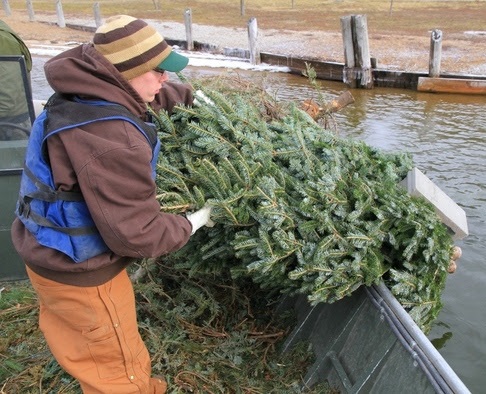 What better Christmas present could there be than a new home? Of course, some anglers might say an improved chance to catch some fish would be at the top of their list.
What better Christmas present could there be than a new home? Of course, some anglers might say an improved chance to catch some fish would be at the top of their list.
Christmas trees can check both boxes off the list by creating a place for fish to live and giving an advantage to anglers.
The Missouri Department of Conservation (MDC) is accepting used natural Christmas trees to create fish habitat in north St. Louis County’s Spanish Lake Park, Lake 34 on the August A. Busch Conservation Area in St. Charles, and Cuivre River State Park in Lincoln County for use in the park’s Lake Lincoln.
So how does recycling a used Christmas tree give fish something to celebrate? Turns out, a bunch of them can create the aquatic equivalent of an underwater condominium.
“A lot of lakes we work with are manmade and there’s not much fish cover in them, so we have to figure out how to put fish habitat in those lakes,” said Kevin Meneau, MDC Fisheries Management Biologist. “Christmas trees are one of the best ways to do that in winter.”
According to Meneau, the trees provide woody cover that makes excellent habitat for invertebrates. These are an ideal food source for smaller fish, which draws them in like a magnet. This in turn brings in bigger fish and creates a situation that gives a boost to the lake’s entire food chain.
“They also help young fish,” Meneau added, “because when the adults spawn their young can hide in those trees.”
The trees benefit some of the most popular fish that anglers like to pursue, including largemouth bass, bluegill, redear sunfish and crappie.
Since these fish typically spawn in shallow water, the trees are tied to cement blocks and submerged at depths of four-to-seven feet to give emerging fish easy access to their cover.
The underwater brush piles concentrate fish, so the submerged trees can be a boon for anglers as well. By noting the location of the trees, astute anglers can focus their efforts in these areas to improve their odds. Meneau said the tree tops are usually visible for five-to-six weeks after being put into the lake before they become water logged and sink completely. This gives anglers until about mid-March to locate these potential fishing jackpots. Resourceful anglers often mark the sites for future reference on maps they make themselves or by using a GPS.
Meneau said it’s best to drop off the entire tree, without cutting it up or removing any branches. Tree donors should remove all decorations, including lights, garland, and ornaments before drop off.
Details regarding tree drop off locations are as follows:
- Spanish Lake Park—12500 Spanish Pond Road, which is east off Bellefontaine Road approximately a half mile north of I-270. Signs at the park will indicate the drop off point.
- August A. Busch Memorial Conservation Area—2360 Highway D, St. Charles. The entrance to the August A. Busch Conservation Area is on Route D, two miles west of Highway 94. Signs on the area will guide visitors to the drop off point at Lake 34.
- Cuivre River State Park–678 State Route 147. The park is located four miles east of Troy. Look for signs identifying the drop off location.
Christmas trees can be donated at these lakes between now and Jan.6, 2019.
